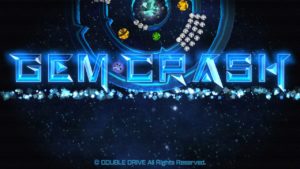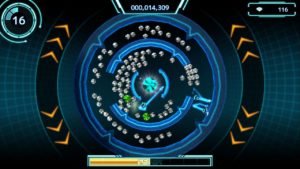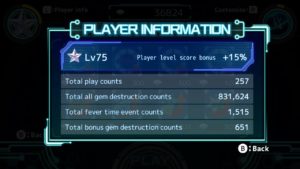
For whatever reason I really enjoy simple games where stuff bounces into other stuff and there’s destruction everywhere. This is especially true when you get to take all that stuff you just collected or demolished and use it to become even more awesome as you go on. These types of games take my favorite aspect of roguelikes – the continual growth and becoming more powerful in various ways each attempt – and put them to use in an entirely new genre. So when I saw a game with some potential on the Nintendo Switch, Gem Crash, I was really intrigued!

Gem Crash puts a unique spin on the genre, giving you a set time limit to score as many points and destroy as many gems as you can. To do this, you rotate the various circular walls by moving the joystick to the right or left and the crasher balls will bounce where they please. The walls have various points that jut out that can be used to deflect the crasher balls the way you want them (hopefully), and between these and the gaps in each of the inner rings you can guide the crasher balls where you want, typically toward gems, increase gems (which give you an extra crasher ball for the level), and the ultimate goal – the prism gem(s). Hitting a prism gem enough times will kick off fever mode which pauses the timer and throws a bonus gem in the middle of the area while removing all the obstacles and granting a bunch of extra bonuses, but once fever time ends there’s an 8 second wait before the prism gem(s) is replaced.

The thing is, this game could practically be called an idle game. After playing a few dozen rounds I decided to test how well a round would go without any input from me whatsoever, and I was shocked to discover that it averaged about 80% as good as my record! This is made even worse by the amount of time it takes to unlock things. Normally in a repetitive game like this, part of what keeps people coming back is chasing that next unlock and the curiosity of what else the game is hiding. In Gem Crash there are only 5 levels, 8 temporary buffs, and 6 stats to upgrade. To put it into some perspective, at the time of this review I played 257 rounds (well, I played about 50 rounds and let the game play itself around 200 times), and it took 254 of those rounds to unlock all the levels and buffs. The temporary buffs last for one round and cost gems to use, as do the stat upgrades, but I found that it was always worth the cost to use all the buffs anyway. Sadly, gems are slow to accumulate, so I was only able to purchase around 60% of the upgrades so far and further upgrades cost so much that it takes an average of 10-20 plays for each one.

The gameplay in general is repetitive as well. While there are 5 levels, they aren’t terribly different, and the goal is always the same: collect lots of gems, then bust up the prism gem(s) as fast as you can so you can get into fever mode and try to break the bonus gem. However, it takes a BUNCH of upgrades before you can break each additional bonus gem. Each time you break a bonus gem, the next time you go into fever mode the bonus gem is bigger and takes much more damage to destroy. As such, as soon as you’re able to break one for the first time, you’re only able to knock out about 10-20% of the next one’s health. Again, for perspective, with all of the things I’ve unlocked and the 250+ rounds I played, I was still only able to destroy 3 bonus gems and almost a fourth. It was nice that one of the levels separates the play area into three with teleporters, and the second level (the one the game plays itself the best) has three prism gems instead of just one, but otherwise they were all basically the same with a tiny difference.

The game has some pretty epic guitar background music, and the sound effects were pretty good at driving some hype, especially once you get lots of upgrades and are demolishing gems left and right. This is probably my biggest positive about the game, though, and aside from the repetition the game really needed work with the language. The English is full of errors, but it’s also confusing at times. For example, there’s no explanation of what the upgrades are, so you just have to guess at exactly what they do. “Increase”, for example, gives you an extra ball for each crasher ball you have when you go into fever mode, but I never would’ve guessed that before I bought the first level of the upgrade. “Penetration” seems to allow your crasher balls to go through additional gems (presumably if the “Attack” stat is also high enough?) but with a number like 5.4, what exactly does that mean? The game’s tutorial is also hidden, and I didn’t expect that when I started the first level I wouldn’t know anything about the game at all. To get to it, you have to return to the main menu, go down to options, and then click Tutorial, but even then it’s just a few arcade-style screens of text and images, not an actual tutorial.

Gem Crash had some potential, but it ended up being painfully repetitive with upgrades and unlocks spaced so far apart that I let the game essentially play itself for a good 6-8 hours just so I could get a feel of everything, and the unlocks were rather infuriating once I realized what they all were. Experience is gained based on your score, and it’s what levels you up, which then unlocks levels and the temporary buffs… but the last temporary buff is an experience buff, which comes far too late to be useful! And when it comes down to it, if there’s almost an imperceptible difference between my score when I play a round from start to end and when I play for 5 seconds of it and then set it down and let the rest of the round play itself, why even play it?
Gem Crash is available on Nintendo Switch.
A review code was provided for this review.

